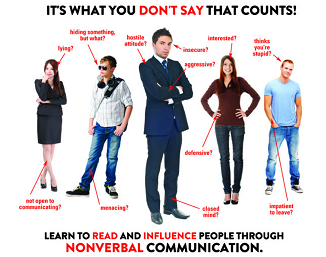This is a guest post with edits by Lei Han
Often, business communications take place remotely by phone or teleconference. However, negotiation experts recommend to always have important negotiations in person so you can take advantage of seeing all the non-verbal cues of the other party. People often subconsciously give away their thoughts and intended actions in a multitude of small ways through expression and body movement. Understanding non-verbal cues can help smooth interactions, enhance communication, and even provide a material advantage.
Below are six aspects of body language you can study and practice in order to optimize use of body language and improve your overall negotiation skills.
1. Maintain Healthy Posture
Often, the first thing that will be noticed about you when entering a room or introducing yourself is posture and gait. Making a positive first impression using posture is vital in instantly projecting that you are someone who respects themselves and should be taken seriously. A straight spine, squared shoulders and purposeful movements indicate that you are alert, prepared, and confident. Conversely, if you are slumped in a seat, it subtly conveys the opposite.
Practice straight, healthy posture both when you are sitting down and standing. Just as with eye contact, postures used in combination with other body expressions can affect positive and negative interpretations of the situation (on both your end and the negotiating party’s). For instance, keeping a healthy posture with balanced, relaxed eye contact can create a peaceful atmosphere whereas rigid form with unyielding eye contact can be perceived as overly aggressive and unnecessarily unsettling.
2. Find a Relaxed Stance
In a state of nerves, it can seem like an impossible feat to relax your body. No matter how uncertain you are, it is important to practice physical relaxation and project whatever kind confidence you can muster. This small nonverbal cue can make the difference between getting the deal you had in mind and being hard-balled into an agreement that is more favorable to the other party. Naturally, negotiations can be intense, so utilizing purposeful body movements to ease tension can create an atmosphere of trust and smoother communication. Physically leaning into conversation, keeping the head at-level or below the other’s, even breathing, and keeping the limbs crossed contribute to a relaxed stance.
If your negotiating partner is someone with whom you see in-person on a normal basis, you can practice baselining. This refers to the observation of a negotiating partner when they are not in a pressured situation. Knowing how someone responds in a low-stress situation can aid in interpreting someone’s changes in physical behavior in a higher-stakes negotiation scenario.
3. Use Appropriate Eye Contact
It’s no surprise that where we fix and how we use our gaze during a negotiation can greatly affect interpretation and outcome. Eye contact can be manipulated to influence perceived openness and a sense of trust. It is most important to maintain a sense of balance in keeping eye contact with a negotiating partner. You should never stare directly for too long. Hold soft eye contact for consistent periods at a time, and feel free to occasionally glance away.
A lack of balanced eye contact can communicate a subsequent lack of confidence. Eye contact is especially important in “gesture clusters”, aka non-verbal cues, in which a series of motions and postures are used in succession that communicate certain underlying emotions or viewpoints. Maintaining proper eye contact in conjunction with the other recommendations in this article communicates openness and friendliness, which can lead the other party to talk more openly about their perspective.
4. Limit Fidgeting
An excess of nervous energy often makes its presence known through your body language without awareness or a sense of control. If you enter negotiations with the fact that you are anxious clearly on display, this can play to a negotiating partner’s advantage. Pen tapping, playing with nearby objects, wiggling your feet, and fidgeting with your hands are clear giveaways that your nerves are unsettled.
Pay attention to what you do with your hands and feet when you are nervous, and practice stopping these behaviors well before the scheduled negotiation. Practice keeping hands in your lap or simply lacing the fingers together on the table. Some people have a tendency to subconsciously “talk with their hands” and this can be a weakness when those hands are communicating without intention! Keep feet flat on the ground and the legs uncrossed.
5. Keep an Open Expression
Keeping an open expression includes relaxed facial muscles, soft eyes, and a loosened jaw. This makes you appear calm, which subtly lets the other person know that you are confident. Coming in with tight lips, narrowed eyes, and a tense, gripped jaw can send negative signals that won’t be productive for effective communication. Another way to project openness is to
use a subtle head nod when listening to the other party ... read more




